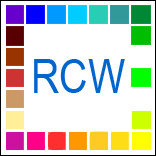Thank you again! I have set out to make many color harmonies in the past few days, and am happy that I'm doing so, correctly! I do love the full 36 color wheel, and have printed it out to keep in my studio and to take in the field, plus a few of the color combos that I will use often, hopefully, eventually I'll memorize all my preferences.
What a relief, to be on a winning track to successful harmonies with the RCW. The study of art and painting is endless, and this feels like such a valuable piece to the puzzle, once I understand fully, will share with my students.
Happy painting!
Carole
----- Original Message -----
From: Don Jusko
To: Chris and Carole Mayne
Sent: Friday, February 09, 2007 4:47 PM
Subject: Re: Two questions, 2/9/7, Chris, Don
Chris and Carole wrote:
> Dear Don,
> Thank you for making this in-depth study of the RCW. I can't imagine why this has eluded me until now! I've already done some color studies, swatches, and am enjoying this new direction.
> I just read about the Munsell wheel in Harley Brown's ''Eternal Truths'' book, and the way he utilizes the discords: ''Choose one dominant color, then two discords, which are equal distance from the color and themselves''. What I can't find in your informative site, is information about the discords, which gives rise to these questions:
Hi Carole.
You know Munsell uses the wrong primaries, right? So that means he has the wrong secondaries also.
What he calls discords, I call split complements.
> 1.Do I understand correctly that you use an equalateral triangle and count by thirds around the RCW wheel?
Yes, I start with an equilateral triangle. Each color is one degree in 360 degrees. Each main division of color is ten degrees. That gives me a 36 hue color wheel. Each color has an opposite. An equal number count on each side of the opposite makes the split complement.
> In Harley's illustration the discord selection seems to go past the colors and makes a smaller distance between the discords--I'm confused!
His color wheel is lopsided. He has no place for magenta or cyan. It's only today's people backers that are trying to include the cyan and magenta and they can't do it with the 5 or 8 colors Munsell choose. But they keep trying.. and confusing people.
> 2. Does using a dash of the compliment work with an analogous color grouping in the same way as with the RBY wheel?
It doesn't work with the RBY color wheel, it's primaries and secondaries are wrong. You could never get a neutral using red and green as opposites. Or any other complement set on the RBY color wheel. Any analogous grouping would also be wrong.
My color wheel is correct, right down to the way each of the 36 colors get darker. Don't confuse the way my colors get darker with the way the computers Yellow, Magenta and cyan color wheel's colors get darker.
The computer only subtracts light which is equal to adding black pigment. Black pigment effects yellow by turning it greener (cool) instead of redder (warm), like the Rutile crystal. It effects cyan by making it greener also, I made it bluer, like the Iceland Spar crystal. There are many crystals that match my color wheel (all of them) and they don't match any other color wheel theory. The Real Color Wheel could also be called the Element Color Wheel or the Crystal Color Wheel.
http://www.realcolorwheel.com/crystals.htm I think you will like this page, it documents the start of the RBY color wheel. It's a big page, but you should read it all once.
http://www.realcolorwheel.com/parkhurstupdate.htm> Sincerely,
> Carole

 Home
Home

 Help
Help

 Search
Search

 Login
Login

 Register
Register

 Broadcast Message to Admin(s)
Broadcast Message to Admin(s)

 « Home
« Home  ‹ Board
‹ Board  Top of this page
Top of this page 
 Pages: 1
Pages: 1

